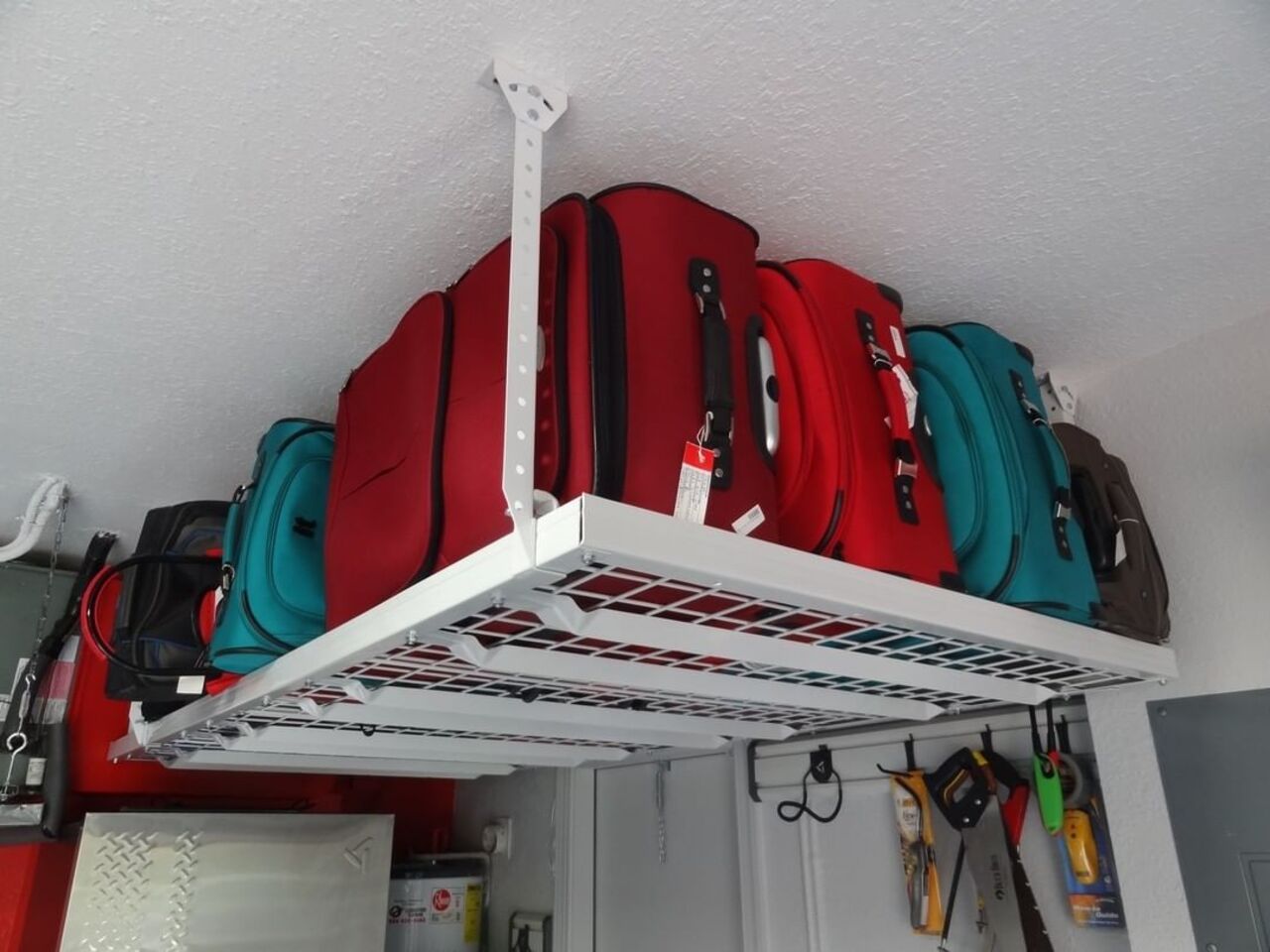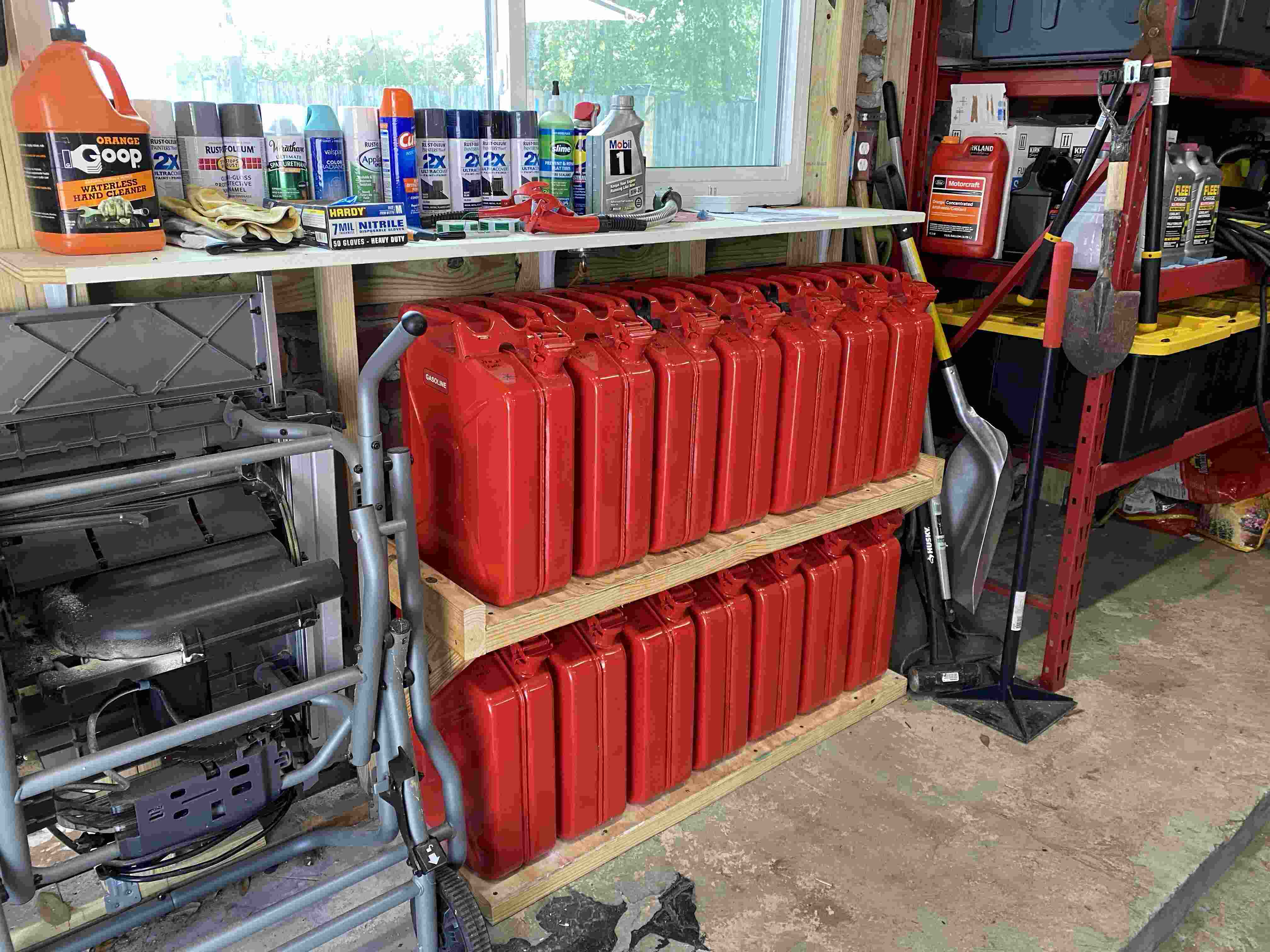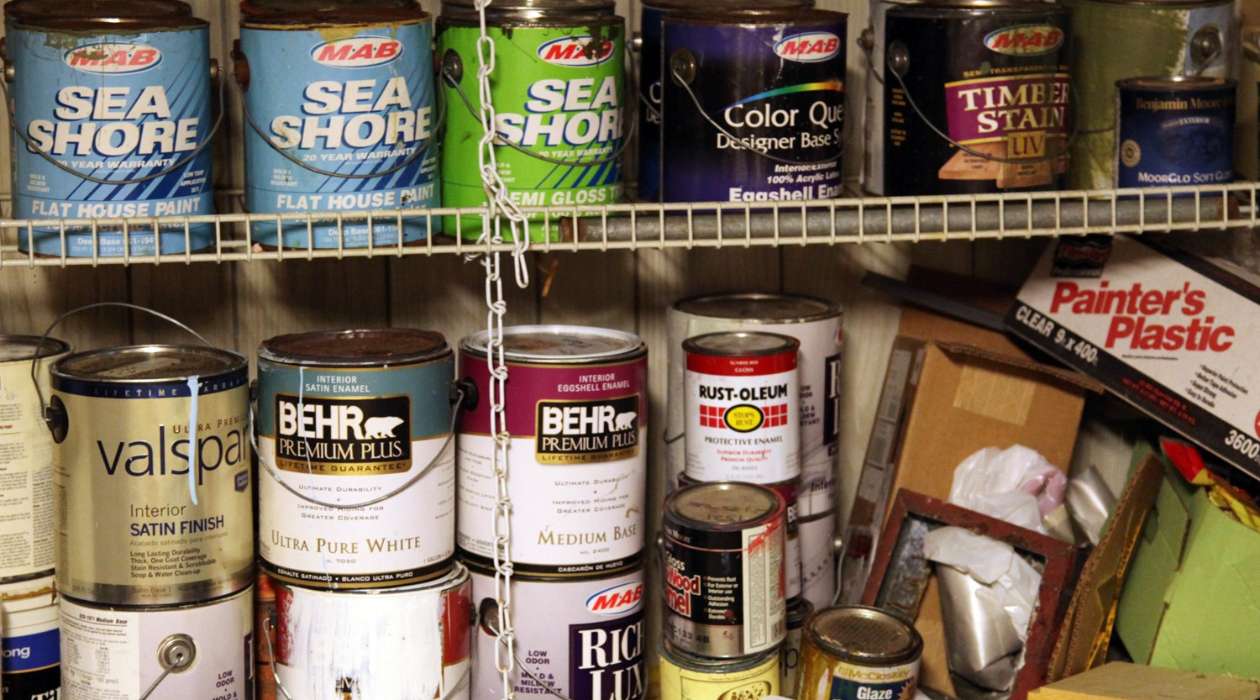

Articles
How To Store Clothing In Garage
Modified: October 27, 2024
Learn the best way to store clothing in your garage with these helpful articles. Keep your clothes organized and protected from dust and moisture.
(Many of the links in this article redirect to a specific reviewed product. Your purchase of these products through affiliate links helps to generate commission for Storables.com, at no extra cost. Learn more)
Introduction
Welcome to our comprehensive guide on storing clothing in your garage. If you find yourself with limited closet space or simply want to store seasonal clothing items, utilizing your garage as a storage solution can be a convenient option. However, it is important to take the necessary steps to ensure your clothing remains in good condition while stored in this unique environment.
In this article, we will provide you with all the information you need to successfully store clothing in your garage. We will discuss how to assess your garage space, prepare clothing for storage, select appropriate storage containers, and organize your clothing efficiently. Additionally, we will cover the importance of maintaining proper conditions for storage and address common storage issues you may encounter. By the end of this guide, you will be well-equipped to store your clothing in the garage in a way that keeps them protected and easily accessible.
So let’s dive in and learn how to store your clothing in the garage effectively!
Key Takeaways:
- Properly assess your garage space, prepare clothing for storage, select appropriate storage containers, and maintain optimal conditions to safeguard your garments while stored in the garage.
- Organize your clothing strategically, address common storage issues, and handle retrieved garments with care to ensure they remain in excellent condition throughout the storage period.
Read more: How To Store Winter Clothes In Garage
Assessing Garage Space
Before you begin storing your clothing in the garage, it’s essential to assess the available space and determine the best storage solution for your needs. Here are a few key points to consider:
1. Evaluate the Climate
The climate in your area is an important factor to consider when storing clothing in the garage. Extreme temperature fluctuations, excessive humidity, or dampness can potentially damage your garments. Ideally, the garage should be well-insulated and have a controlled environment. If your garage experiences extreme temperature variations or high humidity levels, you may need to take extra precautions to protect your clothing.
2. Check for Moisture and Pests
Inspect the garage for any signs of moisture, leaks, or pests. Moisture can lead to mold and mildew growth, which can ruin your clothing. Additionally, pests like rodents and insects can cause damage by chewing through fabrics or nesting in your clothes. Seal any cracks or gaps in the garage walls, windows, or doors to prevent the entry of pests. Consider using pest control measures, such as traps or deterrents, if necessary.
3. Assess Available Space
Take stock of the available space in your garage and determine how much clothing you need to store. Consider whether you have floor space, wall space, or overhead space that can be utilized for storage. This will help you decide on the types of storage solutions that will work best for your specific needs.
Read more: How To Store Shoes In Garage
4. Consider Accessibility
Think about how easily you can access your stored clothing in the garage. If you plan on frequently rotating your seasonal wardrobe, consider using storage solutions that offer easy access, such as hanging racks or clear bins. If you have limited space and need to maximize storage capacity, consider utilizing overhead storage systems or vacuum-sealed bags.
By carefully assessing your garage space, evaluating the climate conditions, checking for moisture and pests, and considering accessibility, you will be able to determine the most suitable storage method for your clothing. This will ensure that your garments stay protected and easily accessible throughout the storage period.
Preparing Clothing for Storage
Properly preparing your clothing for storage is crucial to maintain their condition and prevent any potential damage. Follow these steps to ensure your garments are ready for long-term storage in the garage:
1. Clean and Launder
Before storing any clothing items, make sure they are clean and free from any dirt, stains, or odors. Launder or dry clean your clothes according to their care instructions. Storing dirty garments can attract pests and lead to unpleasant odors or even irreversible stains.
2. Remove Attachments and Accessories
Detach any removable accessories, such as belts, scarves, or jewelry, from your clothing items. These attachments can cause damage or become tangled during storage. Keep them separately in labeled containers or bags to ensure they don’t get lost or misplaced.
Read more: How To Store Clothes In Garage
3. Inspect for Damage
Take the time to inspect each garment for any visible damage or weak areas, such as loose buttons, frayed hems, or torn seams. Repair any damages before storing to prevent them from worsening during storage. This will ensure that your clothing remains in good condition until you’re ready to wear them again.
4. Fold or Hang Appropriately
Determine whether each clothing item should be folded or hung based on its fabric and structure. Delicate items, such as silk blouses or knitwear, are better stored folded to prevent stretching. Hang sturdy fabric items like blazers, coats, or dresses on quality hangers to maintain their shape. Avoid using wire hangers, as they can cause creases and distortion.
5. Use Protective Measures
Protect your clothing from dust, dirt, and potential pests by using suitable protective measures. For folded clothing, place them in clean, breathable fabric storage bags or plastic storage bins. Avoid using plastic bags for long-term storage, as they can trap moisture and lead to mildew growth. Add a sheet of acid-free tissue paper between each folded garment to prevent color transfer and creasing.
For hanging clothing, consider using garment bags or canvas covers to shield them from dust and sunlight. These covers will also provide an extra layer of protection against potential pest infestation.
By following these steps and properly preparing your clothing for storage, you will ensure that your garments remain clean, undamaged, and ready to wear whenever you retrieve them from the garage.
Selecting Appropriate Storage Containers
Choosing the right storage containers for your clothing is essential to protect them from dust, moisture, pests, and other potential damage. Here are some factors to consider when selecting storage containers for your garments:
Read more: How To Store Indian Clothes
1. Breathability
Opt for storage containers that allow for proper airflow to prevent the accumulation of moisture. Avoid airtight containers or plastic bags, as they can trap moisture and lead to mildew growth. Instead, choose breathable fabric storage bags or containers made from materials like canvas or cotton. These materials allow air circulation while keeping your clothing protected.
2. Size and Shape
Consider the size and shape of the storage containers based on the type and quantity of clothing you have. Large, rectangular containers are ideal for storing folded clothing, while long garment bags or hanging storage solutions work well for hanging garments. Ensure that the containers fit well in your garage space and can be stacked or arranged efficiently to maximize storage capacity.
3. Durability
Look for storage containers that are durable and can withstand the conditions of your garage. Strong containers made from sturdy materials will protect your clothing and shield them from potential damage. Avoid using flimsy or easily breakable containers that may not hold up well over time.
4. Clear or Labeled
Consider whether you prefer clear storage containers or containers that can be labeled. Clear containers allow you to easily see the contents without having to open them, making it convenient to locate specific clothing items. Labeled containers, on the other hand, provide a systematic approach and make it easier to identify and retrieve specific garments.
Read more: How To Store Ski Clothes
5. Pest-Resistant
If your garage is prone to pests, choose storage containers that have additional pest-resistant features. Look for containers with tight-fitting lids or those that can be sealed to prevent pests from entering. You can also consider using natural pest deterrents, like cedar chips or lavender sachets, to further protect your clothing.
By considering factors such as breathability, size and shape, durability, clarity or labeling, and pest-resistance when selecting storage containers, you will ensure that your clothing remains well-protected and easily accessible throughout their time in storage in the garage.
Organizing Clothing in the Garage
Proper organization is key to efficiently storing your clothing in the garage. By organizing your garments strategically, you can maximize space utilization and easily locate specific items when needed. Here are some tips for organizing your clothing:
1. Categorize Your Clothing
Start by categorizing your clothing items into groups, such as tops, bottoms, dresses, outerwear, and accessories. This will help you determine the best storage method for each category and allow for easier retrieval later on.
2. Utilize Storage Systems
Consider using storage systems specifically designed for clothing organization, such as clothing racks, shelving units, or hanging organizers. These systems can provide additional hanging or stacking space and help keep your clothing orderly. Use them to separate different categories of clothing or to store frequently accessed items for easy reach.
Read more: How To Store Barbie Clothes
3. Utilize Vertical Space
Make the most of your garage’s vertical space by utilizing wall-mounted storage solutions or overhead storage systems. Install hooks, pegboards, or wall-mounted garment racks to hang jackets, bags, or scarves. Utilize overhead shelving for storing seasonal or infrequently used items. This will free up valuable floor space and allow for better organization.
4. Label or Color-Code
To enhance organization and ease of identification, consider labeling your storage containers or using color-coding systems. Label each container or use colored tags to indicate the contents or the category of clothing. This makes it quick and convenient to locate specific items without having to open multiple containers.
5. Create Zones
Create dedicated zones within your garage for different types of clothing or specific family members. This helps in keeping everything organized and easily accessible. For example, you can have a zone for adult clothing, another for children’s clothing, and a separate zone for accessories.
By categorizing your clothing, utilizing storage systems, maximizing vertical space, labeling or color-coding, and creating zones, you can effectively organize your clothing in the garage. This ensures that your garments stay tidy, easily accessible, and well-protected throughout their storage period.
Maintaining Proper Conditions for Storage
Maintaining the proper conditions for storing your clothing in the garage is crucial to preserve their quality and prevent any damage. Here are some essential steps to ensure optimal conditions for storage:
Read more: How To Store Old Clothes
1. Temperature and Humidity Control
Avoid exposing your clothing to extreme temperature fluctuations or high humidity levels. Fluctuating temperatures can cause garments to deteriorate, while high humidity can lead to mold or mildew growth. Aim to maintain a consistent temperature and humidity level in your garage by using a dehumidifier or air conditioning unit if necessary.
2. Protect from Sunlight
Direct sunlight can cause fabrics to fade or become discolored over time. Keep your clothing away from windows or consider using light-filtering curtains or blinds to minimize exposure to sunlight. If you’re using clear storage containers, ensure that they are not placed in direct sunlight.
3. Ventilation
Proper ventilation is essential to prevent stale odors or moisture buildup. Allow for airflow in your garage by keeping windows or vents open whenever possible. This will help reduce the chances of musty smells or mildew formation.
4. Pest Prevention
Take proactive measures to prevent pests from damaging your clothing. Regularly inspect the garage for any signs of pests and implement pest control methods if needed. Keep the garage clean and free from any food or spills that may attract insects or rodents. Consider using natural pest deterrents like lavender sachets or cedar chips.
Read more: How To Store Table Cloths
5. Regular Inspection
Periodically inspect your stored clothing to ensure they are still in good condition. Check for any signs of moisture, pests, or damage. Take the necessary actions, such as repairing any damages or repositioning clothing to avoid prolonged pressure on certain areas.
By maintaining proper temperature and humidity levels, protecting clothing from sunlight, ensuring adequate ventilation, preventing pests, and conducting regular inspections, you will create an optimal storage environment for your garments in the garage. This will help preserve their quality and ensure they remain in excellent condition until you’re ready to wear them again.
Dealing with Common Storage Issues
While storing clothing in the garage can be an effective solution, there are some common issues that may arise. Here’s how to tackle these issues and ensure the safety of your clothing:
1. Odor Control
If you notice any musty or unpleasant odors in your stored clothing, there are several ways to address this issue. One option is to place odor-absorbing products, such as activated charcoal or baking soda, in the storage containers. These products will help neutralize odors over time. Additionally, you can occasionally air out your stored clothing by opening the containers or hanging them outside for a short period.
2. Moisture Prevention
Moisture can be a significant concern when storing clothing in the garage. To prevent moisture buildup, make sure that your garage is dry and well-ventilated. Avoid storing clothing directly on the floor, as this can make them more susceptible to dampness. Instead, use raised shelving or pallets to keep your clothing elevated and away from potential moisture sources.
Read more: How To Store Lumber In Garage
3. Pest Infestation
To protect your clothing from pests, it’s essential to take preventive measures. Seal any gaps or openings in the garage to prevent pests from entering. Consider using natural pest deterrents like cedar chips or lavender sachets, which can help repel insects. If you suspect a pest infestation, take immediate action by using traps or contacting pest control professionals to address the issue.
4. Temperature Regulation
Fluctuating temperatures can have a negative impact on stored clothing. If your garage experiences significant temperature changes, consider using insulated storage containers or placing the clothing in temperature-controlled areas of the garage, such as interior walls or away from direct sunlight. You can also use breathable fabric or canvas covers to provide an additional layer of insulation.
5. Avoid Overpacking
Overpacking storage containers can lead to wrinkles, creases, and damage to your clothing. Avoid cramming too many items into one container, as this can put undue pressure on the garments and result in permanent deformations. Instead, allow for some breathing space within each container to maintain the integrity of the clothing.
By addressing common storage issues related to odor, moisture, pests, temperature regulation, and avoiding overpacking, you can ensure that your clothing remains in excellent condition while stored in the garage. Regular maintenance and proactive measures will go a long way in preserving the quality and longevity of your garments.
Retrieving and Unpacking Stored Clothing
When the time comes to retrieve your clothing from storage in the garage, it’s important to do so carefully to ensure that your garments remain in good condition. Here are some steps to follow when retrieving and unpacking your stored clothing:
Read more: How To Store Kayak In Garage
1. Plan Ahead
Before you start retrieving your clothing, take some time to plan and make a list of the specific items you need. This will help streamline the retrieval process and minimize the time spent searching for particular garments.
2. Clean the Workspace
Clean the garage floor or designated workspace where you will be unpacking the clothing. Sweep away any dirt or debris, ensuring that the area is clean and free from anything that could potentially damage the garments.
3. Handle with Care
When removing clothing from storage containers or racks, handle them with care to avoid unnecessary wrinkles or damage. Gently unfold or unhang each item, being mindful of delicate fabrics or intricate designs.
4. Inspect for Damage
As you unpack each garment, inspect them for any signs of damage or pests. Check for stains, loose threads, or any other issues that may have occurred during the storage period. Address any damages appropriately, such as washing or repairing the garments if needed.
Read more: How To Store A Couch In A Garage
5. Air Out and Freshen
If your stored clothing has a slight musty odor from being in the garage, you can freshen them up by hanging them outside for a short period or using fabric fresheners. Alternatively, you can also spot clean or launder the items before wearing them to ensure they are fresh and ready to be worn.
6. Re-Organize and Store Unwanted Items
As you go through your clothing, consider re-organizing them based on your current needs. Separate any items you no longer want or need and set them aside for donation or storage in a different location. This will help declutter and create space for other items you may want to access more frequently.
7. Properly Store Unwanted Clothing
If you have clothing that you no longer plan to wear but still want to keep, make sure to properly store them in appropriate containers or bags. Clean and fold the items, and place them in clean and breathable storage bags or containers. Label them accordingly for easy identification in the future.
By following these steps when retrieving and unpacking your stored clothing, you can ensure that your garments are handled with care, inspected for any damage, and prepared for immediate wear or appropriate storage. This will allow you to effortlessly integrate your clothing back into your wardrobe while maintaining their quality and longevity.
Conclusion
Storing clothing in the garage can be a practical solution for those with limited closet space or a need for seasonal storage. By following the steps outlined in this comprehensive guide, you can ensure that your clothing remains in good condition while stored in this unique environment.
From assessing your garage space and preparing your clothing for storage to selecting appropriate storage containers, organizing your garments, and maintaining proper storage conditions—each step plays a crucial role in safeguarding your clothing during their time in the garage.
Remember to assess the climate and conditions in your garage, taking measures to control temperature, humidity, and pests. Clean and prepare your clothing properly before storage, select suitable storage containers, and organize your garments strategically for easy access.
Throughout the storage period, be vigilant in maintaining the proper conditions in the garage, addressing common storage issues promptly, and conducting regular inspections to ensure the well-being of your garments.
When the time comes to retrieve and unpack your stored clothing, handle each item with care, inspect for any damage, and freshen them up if necessary. Reorganize your wardrobe as needed, and properly store any unwanted items for future use or donation.
By following these guidelines, you can store your clothing in the garage with confidence, knowing that they will remain protected, organized, and ready to wear whenever you need them.
So go ahead, utilize your garage space as an efficient and convenient storage solution for your clothing, and enjoy a more organized and functional wardrobe!
Frequently Asked Questions about How To Store Clothing In Garage
Was this page helpful?
At Storables.com, we guarantee accurate and reliable information. Our content, validated by Expert Board Contributors, is crafted following stringent Editorial Policies. We're committed to providing you with well-researched, expert-backed insights for all your informational needs.






0 thoughts on “How To Store Clothing In Garage”